Last fall at the Folk School the class I took in marbling used a different brand of paint than I use. The instructor gave us the left-overs to take home (thank you, Pat!) but I hadn’t had time to use it. I find that using a product in a class is very different than using it in my own studio. Timing is different, paper is different, even the water is different, so I don’t like to make decisions until I’ve had time to play on my own and with my normal supplies. All I can say is that I love the new stuff! It’s Golden’s Fluid Acrylics and I am finding them much easier to use than the old and they seem to be sharper and more coherent than the old brand. Here are some of the papers that I made this week.
I’m thrilled with the black and grey piece. I have tried mono-tone marbling in the past and haven’t been completely satisfied with the results, but this one works. I’m hoping it’s the new paints and I foresee trying a batch of mono-tones in my next marbling session.
I also tried some more overmarbling with less than stellar results. I’ll post the before and afters in a few days for your comments.

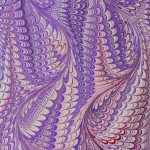
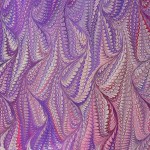
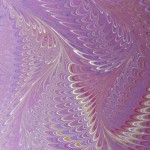
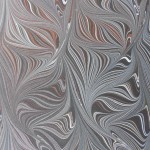
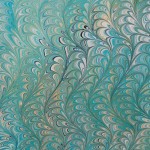
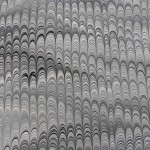
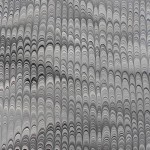
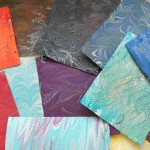
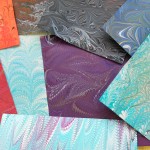
Pingback: Monochromatic Rainbow | Losing Her Marbles
Hi Loosing Her Marbles,
I’ve been marbling paper and using it in my studio practice for several years but still consider myself a novice of the craft. I recently took a coarse at the Textile Arts Center to improve skills and the instructor suggested using liquitex fluid flow acrylics instead of the expensive fw acrylic inks I was using. The acrylic inks worked beautifully but are too expensive for the scale of work I’m trying to make. I’m having trouble balancing the thickness of the acrylic paint. It seems to sink a lot even when I add water. When I add surfactant (kodak photoflo or liquitex pouring medium) it both sinks and spreads leaving only a faint print. Do you have any suggestions on what I can do with the liquitex paint? Maybe I have my ratios wrong? When I run out of this batch of paint I will try the golden, it looks like it’s working well for you, in the mean time, I look forward to your suggestions.
thanks for your time, I love your blog!
Sincerely,
Jason Rondinelli
Hi Jason,
Thanks for your kind words. I started out with Liquitex Basics and struggled every session to get them balanced correctly, so I know your problem. It was such a relief when I changed to Golden. BTW, Golden now makes a High Flow acrylic which I’ve tried, but find it spreads too much, so I prefer the regular Fluid Acrylics.
I haven’t used the Liquitex in over a year, but this was my method. I made the paint the night before marbling as it seemed to dissolve better if left to stand. As I remember, the mixture was about 1/3 water to 2/3 paint, but different colors reacted differently. The consistency should be like tomato soup or thin cream. The most important thing was to stir the paint forever – at least 50 stirs until there were no granules. It was a real pain!
Not knowing what I was doing at first, I also tried some heavy body acrylics, but that was a complete disaster. I could never get the paint the right consistency which sounds like your problem.
Golden’s Flow Release is perfect for a surfactant, but be very careful with it. Only one drop per color should be plenty and some colors, especially yellows and reds, really don’t need it.
I would suggest you get a few colors of the Golden Fluid Acrylics as a trial and see how it goes. That’s what I did, and never used the Liquitex again! I thought I would, but after 6 months I donated it to our local arts center.
One warning, even the Golden needs monitoring. Certain colors, especially the ultramarines and metallics drop out of suspension and need to be stirred with almost every use.
Hope this helps a bit. Good luck with your marbling and please ask if you have any other questions.
Nancy
Hi Nancy,
Thank you for the generous tips! Over the week I did experiment with the Golden Liquid Acrylics and decided to just use it for my project. The paint printed very nicely. I did encounter a problem with some areas appearing grainy, like part of the pigment was sinking or separating in an even formation. If you have any thoughts on the issue I’m all ears.
Thanks again, you’ve been very helpful! – Jason
Stir, stir stir and stir again!!!! It happens all the time with the metallics. The metallic color is actually tiny pieces of colored mica which drop out of suspension very easily. Sometimes I even stir before filling every dropper. I assume you are using droppers rather than whisks. One drop of the flow release can help. Some paint will always drop out, but at the end of the session, your tray shouldn’t be coated with paint. Some drops are normal. There’s a slight chance your carageenan ( or whatever you are using as size) is too thin, but that’s unusual if you are following the normal directions – 2 or 2.5tbs per gallon.
I visited your web page – very impressed. You might want to look into suminagashi techniques, rather than the ebru that I use. There are some great YouTube videos. Awesome guy It’s done with ink on plain water (not carageenan). Each brush has a different color and the tip is touched gently on the surface of the water. Concentric circles are formed. Then the magic happens. You blow gently or fan lightly and the ink forms patterns. Masters can make landscapes or pictures. I can make contour lines!
Good luck and feel free to ask anything else.
Nancy
I had a question about the Golden paints. I have been using the High Flow acrylics a for about 4 marbling sessions and I like them; but with the Fluid Acrylics, how do you go about diluting them? Ive used the Fluid Acrylic once with the Carbon Black and it turned out very well; however, since you use them on a regular basis, I was hoping you could give some specifics ratios or something.
Secondly, can you recommend a book or any other material that would help a beginner reproduce patterns similar to your work?
Hi Jeremy,
Thanks for stopping by my blog. I’m afraid that I’m very imprecise about my measurements, but I add about equal parts of the Fluid Acrylics and water to start. My first few papers are used for testing and I add more water a few drops at a time, if needed. I add less water to yellows & reds as they seem to spread more. If a color – like ultramarine blue – doesn’t spread well, I add just one drop of Golden Acrylic Flow Release. It’s really just testing and playing rather than a formula for me. This is one reason I always start with eye droppers rather than whisks. I can gauge the strength of the spread much better with the concentric circles rather than random drops.
I find that the High Flow spreads too much straight from the bottle, so I have to be very careful with them. Sometimes I’ll just dip a stylus into the paint and touching it to the carrageenan is plenty.
This is the book that I always keep within reach when I marble.
Marbled Designs: A Complete Guide to Fifty-Five Elegant Patterns Hardcover – October 1, 1993 by Patty Schleicher (Author), Mimi Schleicher (Author)
I don’t always follow their patterns exactly, but they are great places to begin and the diagrams are easy to understand.
Good luck with your marbling. Stop by any time if you have more questions.
Nancy
Wonderful, thank you for the tips. I just purchased a handful of the fluid acrylics, blended up some cara. and will be experimenting today. I’ll let you know how it turns out.